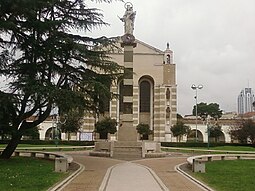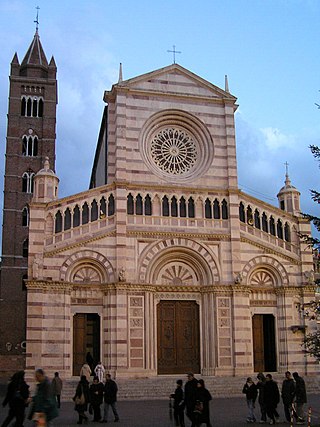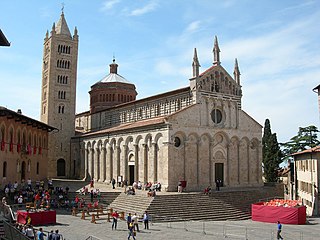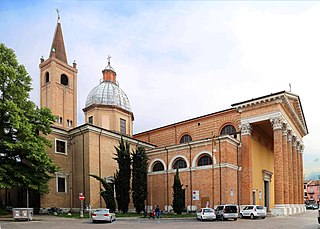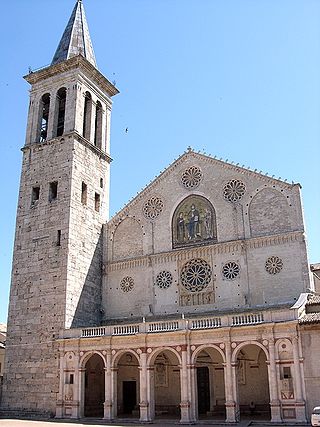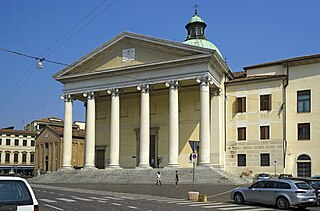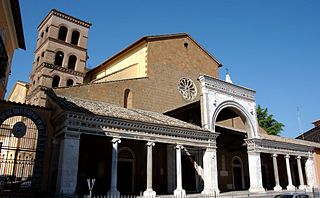History
According to a local tradition, the first bishop of Terracina was St. Epaphroditus, who is claimed to have been one of Jesus' original seventy-two disciples, mentioned by Paul of Tarsus in one of his epistles. [3] The most ancient Christian record of the city is that of the martyrdom of St. Julianus, priest, and St. Cæsareus, deacon, who were cast into the sea under the emperor Trajan. The early date is rejected by Francesco Lanzoni, along with many hagiographical details. [4] In the third century, a Quartus is recorded by the "Passion of S. Caesareo" as a sacerdos, and martyr along with Caesareo; he is also mentioned as a martyr along with Quintus of Capua. There is no reason to think that Quartus was a bishop. [5]
The first bishop whose date is known with certainty is Sabinus. He was present at the Lateran synod of Pope Miltiades in November 313. [6]
It is claimed that an African priest, Silvianus, a fugitive during the Vandal persecution was bishop of Terracina about 443. The catalogue of Hieronymianus notes under 10 February: "iuxta Terracina in Campania natale Silvani episcopi et confessoris." [7] The story of his African origins first appears in an anonymous local historian of Terracina belonging to the 17th and 18th centuries. It is rejected by Francesco Lanzoni as being without foundation. He also rejects the date of 444, preferring to place Silvianus in the 4th century. [8]
Agnellus, Bishop of Fondi, whose city had been destroyed, was appointed cardinalis sacerdos of the diocese of Terracina by Pope Gregory I. [9]
The sees of Piperno [10] (Privernum) and Sezze [11] (Setia), situated on the side of the Lepinian hills, were united to Terracina, perhaps by Pope Alexander III, or even earlier. [12] The union of the three dioceses was confirmed by Pope Honorius III on 18 January 1217, during the episcopate of Simeone. [13]
On 16 July 1725, with the Bull "Regis Pacifici", Pope Benedict XIII restored the See of Piperno and Sezze, declaring them united aeque principaliter to the diocese of Terracina. [14]
Bishop Francesco Antonio Mondelli (1805) was exiled in 1809, for refusing to take the oath of loyalty to Napoleon, following the arrest, deposition and deportation of Pope Pius VII. He was deported first to the fortress of Chambéry in Savoy, and then to Trevoux in France. [15]
The Cistercian Abbey of Fossa Nuova is within the territory of this see. The diocese is immediately subject to the Holy See (Papacy). [16]
Chapters and cathedrals
The cathedral of Terracina, dedicated to S. Cesareo, was built in the 11th and 12th centuries, [17] on foundations of an ancient Roman temple, dedicated to Apollo, [18] or to the Goddess Roma and Augustus. [19] It was served and administered by a corporation, the Chapter, composed of twelve Canons, presided over by the Archpriest. Since the cathedral served as a parish church, the Archdeacon had the "cure of souls" (responsibility for the spiritual welfare of the parishioners). [20]
The cathedral of Latina, dedicated to S. Marco, was begun in 1932 as a parish church, at the same time that Latina was established as a city and the capital of its prefecture. The former Pontine Marshes, which had finally been drained after more than fifty years of work, were opened to agriculture, and the state sponsored a large-scale immigration from the Veneto, whose principal patron saint was Mark the Evangelist of Venice. The new parish church was dedicated on 23 November 1933, by Cardinal Enrico Gasparri, suburbicarian Bishop of Velletri. It was elevated to the status of a cathedral on 30 September 1986. [21]
The original church at Sezze was dedicated to S. Luke, the mythological founder of the Christian community at Setina. There was a Romanesque church, which was seriously damaged in a fire in 1150. The latest known bishop of Sezze was Bishop Landus in 1178. [22] The Romanesque church was replaced, and a new church dedicated on 18 August 1364, by the Franciscan Bishop Giovanni of Terracina, Priverno e Sezze. It was dedicated to the Virgin Mary. Pope Benedict XIII granted the old cathedral the title of "minor basilica". [23] By the papal bull of 29 April 1725, the church of S. Maria was reestablished as a cathedral and united aeque principaliter with the diocese of Terracina. The cathedral was staffed and administered by a Chapter, consisting of three dignities and twelve Canons. [24]
The cathedral of Piperno was dedicated to the Virgin Mary. The old cathedral was destroyed in a fire in 1159, and Pope Lucius III dedicated a new cathedral in the summer of 1183. [25] The cathedral was staffed and administered by a Chapter, consisting of an Archpriest and twelve Canons. [26]
Diocesan reorganization
Pope Leo XIII had determined that all of the dioceses of Lazio should belong to one and the same ecclesiastical province. His successor Pope Pius X, however, decided to split the province into two, Upper Lazio and Lower Lazio (to which Terracina belonged), while the suburbicarian bishops would belong to a separate conference under the direction of the Vicar of the city of Rome. [27] The city of Latina, however, which was the largest in Lazio except for Rome itself, belonged to the diocese of Velletri, one of the suburbicarian bishoprics.
The Second Vatican Council, in order to ensure that all Catholics received proper spiritual attention, decreed the reorganization of the diocesan structure of Italy and the consolidation of small and struggling dioceses, in particular those with financial and personnel problems. [28] It also decreed that the natural population units of people, together with the civil jurisdictions and social institutions that compose their organic structure, should be preserved as far as possible as units. It was their wish that all of Lazio was to belong to one ecclesiastical province. Latina was recognized as an anomaly in terms of ecclesiastical organization. Therefore, on 12 September 1967, with the approval of Pope Paul VI, the Consistorial Congregation ordered that the part of the territory of Lazio that belonged to the district of which Latina was the capital was to be transferred from the diocese of Velletri to the diocese of Terracina, bringing a substantial increase in territory and population to the diocese of Terracina. [29] On the same day, in a separate decree, the name of the diocese was changed to "Terracinensis-Latiniensis, Privernensis et Setinus". [30]
On 18 February 1984, the Vatican and the Italian State signed a new and revised concordat. Based on the revisions, a set of Normae was issued on 15 November 1984, which was accompanied in the next year, on 3 June 1985, by enabling legislation. According to the agreement, the practice of having one bishop govern two separate dioceses at the same time, aeque personaliter, was abolished. This applied to the dioceses of Terracina-Latina and Priverno e Sezza. The Vatican therefore continued consultations which had begun under Pope John XXIII for the merging of dioceses. On 30 September 1986, Pope John Paul II ordered that the dioceses of Terracina-Latina and Priverno e Sezza be merged into one diocese with one bishop, with the Latin title Dioecesis Latinensis-Terracinensis-Setina-Privernensis. The seat of the diocese was to be in Latina, the largest city and capital of the province, and the cathedral of Latina, San Marco, was to serve as the cathedral of the merged dioceses. The cathedrals in Terracina, Sezze, and Priverno were to become co-cathedrals, and the cathedral Chapters were each to be a Capitulum Concathedralis. There was to be only one diocesan Tribunal, in Latina, and likewise one seminary, one College of Consultors, and one Priests' Council. The territory of the new diocese was to include the territory of the former dioceses of Latina, Terracina, Sezze, and Priverno. [31]
Diocesan synods
A diocesan synod was an irregularly held, but important, meeting of the bishop of a diocese and his clergy. Its purpose was (1) to proclaim generally the various decrees already issued by the bishop; (2) to discuss and ratify measures on which the bishop chose to consult with his clergy; (3) to publish statutes and decrees of the diocesan synod, of the provincial synod, and of the Holy See. [32]
In 1640, Bishop Cesare Ventimiglia (1615–1645) presided over a diocesan synod. In 1764. Bishop Francesco Odoardi (1758–1775) held a diocesan synod at Priverno. In 1784, from 30 May to 1 June, Bishop Benedetto Pucilli (1775–1786) held a diocesan synod in the cathedral of Terracina, the decrees of which were published in Rome in 1885 by the Salamonian press. [33]
A diocesan synod of the diocese of Terracina Priverno e Sezze was held by Bishop Salvatore Baccarini (1922–1930) in 1929. [34]
Bishop Giuseppe Petrocchi (1998–2013) presided over the first diocesan synod of the reorganized and renamed diocese of Latina-Terracina-Sezze-Priverno from 2005 to 2012. An extensive report of the consultations, Perché la nostra Chiesa sia "Più-Una", was published. [35]
